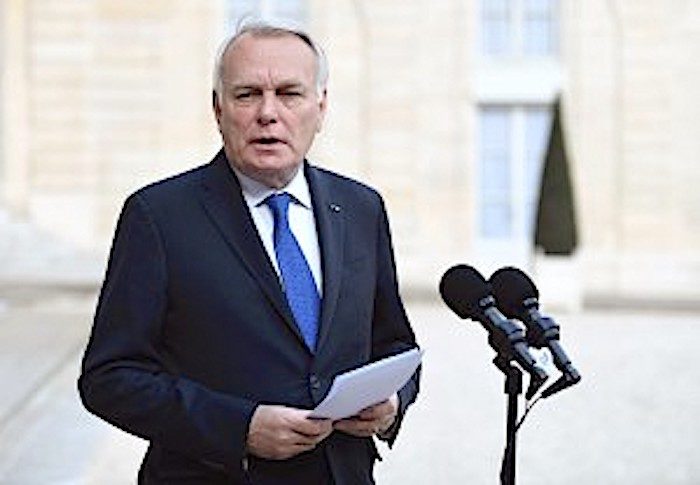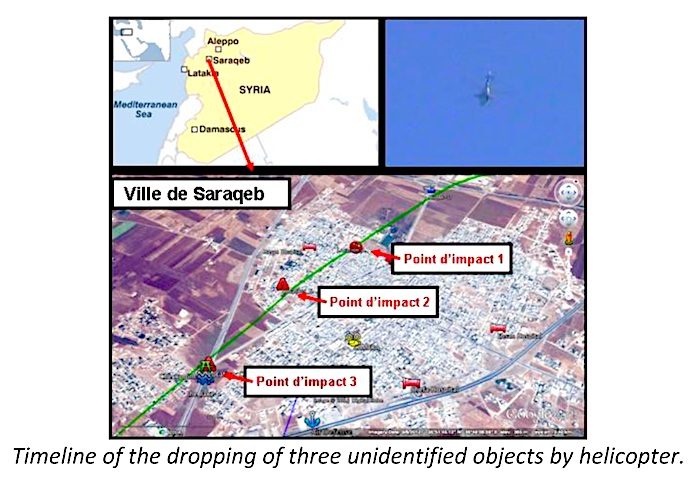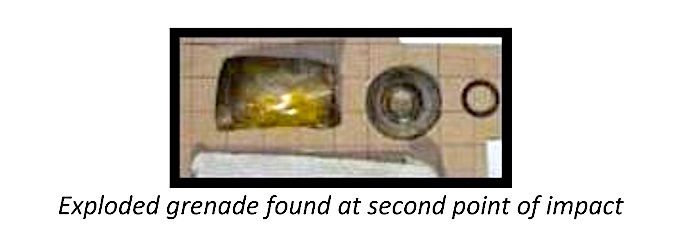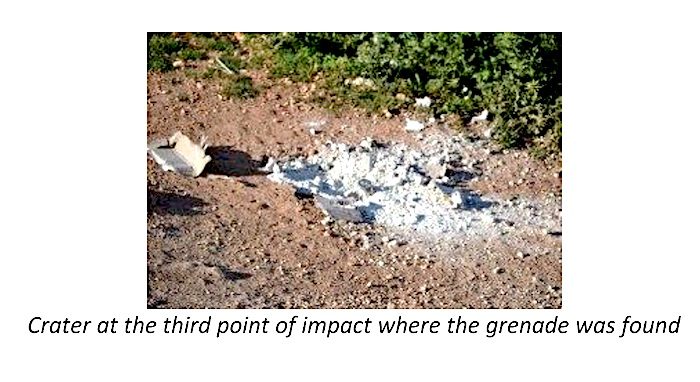[NOTE: This report is far from convincing. The logic is clearly circular. And it does not address the serious issues raised by MIT Professor T. Postol.]
Jean-Marc Ayrault, Minister of Foreign Affairs and International Development, spoke following the restricted meeting of the Defense Council at the Elysée on April 26. He presented the national evaluation providing evidence of the use of sarin gas and the Syrian regime's responsibility in the chemical attack carried out in Khan Sheikhoun on April 4.
Chemical attack of 4 April 2017 (Khan Sheikhoun) — National Evaluation
This document is based on declassified intelligence from France's own sources.
On 4 April 2017, air strikes against civilians in the city of Khan Sheikhoun killed more than 80 people. According to our experts, the symptoms observed immediately afterwards (pupil contraction, suffocation, bluing of lips, white foam on faces, convulsions), the high number of deaths, and the fact that certain responders and medical staff suffered secondary contamination are consistent with the use of a highly lethal neurotoxic agent. This has now been confirmed scientifically.
These strikes come in the context of continuous use since 2013 of chemical weapons or chemical agents in Syria, particularly during air strikes, including after theSyrian regime committed to dismantling its chemical weapons arsenal on 25 October 2013. France has collected biomedical and environmental samples and munitions and pieces of munitions in Syria on several occasions, and has been able to confirm the use of chlorine and sarin several times. The attached table lists France's evaluations.
Comment: Detection of usage doesn't necessarily tell who used it.
1. - Technical analysis of the chemical attack on 4 April
a) France has deployed the required resources to obtain its own samples from the alleged sarin attack on 4 April 2017 in Idlib Governorate.
b) The analyses carried out by French experts on the environmental samples collected at one of the impact points of the chemical attack at Khan Sheikhoun on 4 April 2017 reveal the presence of sarin, of a specific secondary product (diisopropyl methylphosphonate - DIMP) formed during synthesis of sarin from isopropanol and DF (methylphosphonyl difluoride), and hexamine. Analysis of biomedical samples also shows that a victim of the Khan Sheikhoun attack, a sample of whose blood was taken in Syria on the very day of the attack, was exposed to sarin.
France therefore independently and categorically confirms that sarin was used on 4 April. The United States, the United Kingdom, Turkey and the Director-General of the OPCW have also established that sarin was employed on the basis of analysis of biomedical samples.
c) According to the intelligence obtained by the French services, the process of synthesizing sarin, developed by the Scientific Studies and Research Centre (SSRC) and employed by the Syrian armed forces and security services, involves the use of hexamine as a stabilizer. DIMP is also known as a by-product generated by this process.
d) This intelligence on the process used by the regime, which is a sign of its responsibility in the attack on 4 April, is based notably on the analysis of the content of an unexploded grenade which was used with certainty by the Syrian regime during the Saraqib attack on 29 April 2013. That mid-afternoon, a helicopter arriving from the north-east flew over the city of Saraqib at high altitude. Three unidentified objects, emitting white smoke, were dropped on neighbourhoods to the west of the city, on a north-south trajectory.
According to France, only the Syrian armed forces had helicopters and could therefore be responsible for dropping these three objects.
At the first point of impact, there were no victims. At the second point of impact, one person was killed and about 20 injured. An exploded grenade was found in the wreckage. Analysis of biomedical and environmental samples collected by the French services revealed the presence of compounds consistent with exposure to sarin. This analysis was confirmed by the United Nations in December 2013.
At the third point of impact, an unexploded grenade was found in a crater on a dirt track. This munition was very similar in appearance to that found at the second point of impact.
Once the French services were sure of the traceability of the grenade, analyses were carried out.
The chemical analyses carried outshowed that it contained a solid and liquid mix of approximately 100ml of sarin at an estimated purity of 60%. Hexamine, DF and a secondary product, DIMP, were also identified. Modeling, on the basis of the crater's characteristics, confirmed with a very high level of confidence that it was dropped from the air.
e) The presence of the same chemical compounds in the environmental samples collected during the attacks on Khan Sheikhoun on 4 April 2017 and on Saraqib on 29 April 2013 has therefore been formally confirmed by France. The sarin present in the munitions used on 4 April was produced using the same manufacturing process as that used during the sarin attack perpetrated by the Syrian regime in Saraqib. Moreover, the presence of hexamine indicates that this manufacturing process is that developed by the Scientific Studies and Research Centre for the Syrian regime.
2. - Militarily analysis of the tactical situation around 4 April 2017
a) The 4 April attack came after the Syrian armed forces and security services and their supporters launched a counter-offensive in the sector of Hama, responding to the progress of armed groups and Hay'at Tahrir al-Sham in the north of Hama since 22 March.
On 23 March, Syrian elite forces, the Qawat Al-Nimr, along with Hezbollah and the Iranian Quds Force, were redeployed to the area. Syrian and Russian air support has also been focused on this sector. On 2 April, the Syrian armed forces and security services and their supporters pushed back the front line, although Damascus failed to fully win back the territory captured by the armed groups in March. Since then, the regime has largely regained territory in the Hama sector and continues to pressure the opposition: further conventional bombing has been observed in the Hama region.
b) The French services are aware in particular of a Sukhoi Su-22 bomber which took off from the Shayrat Airbase on the morning of 4 April and launched up to six strikes around Khan Sheikhoun.
c) As regards the general organization of the command chain, the French intelligence services assess that only Bashar al-Assad and a few of the most influential members of his inner circle are authorized to give the order to use chemical weapons.
3. - Analysis of the presence of armed groups in Hama and of their capabilities
a) While it has been confirmed that mustard gas attacks have been carried out by Daesh in Syria since 2015, France assesses that the theory of an attack by the armed groups using a neurotoxic agent on 4 April is not credible. France has no information confirming the possession of sarin by these groups.
1. Hay'at Tahrir al-Sham (HTS) was born from the merger of several radical factions with the Al-Qaeda movement Jabhat Fatah al-Sham after the fall of Aleppo. Pragmatic coordination between HTS and other armed groups present in the Hama sector was observed in late March. To the knowledge of the French services, none of these groups has the capability to employ a neurotoxic agent, or the air capacities required.
2. The theory of an attack perpetrated by Daesh is not plausible either, as Daesh is not present in the sector of Hama. Moreover, the French intelligence services have not observed that Daesh has sarin or air capacities.
b) Neither do the French services assess that the theory of a staged attack or manipulation by the opposition is credible, particularly because of the massive influx in a very limited time towards hospitals in Syria and Turkey, and the simultaneous, massive uploading of videos showing symptoms of the use of neurotoxic agents.
4. - Continuation since 2013 of a clandestine Syrian chemical weapons programme
a) In a previous declassified national report in 2013, the French services laid out their knowledge of the Syrian chemical weapons programme and chemical attacks perpetrated by the regime. They noted that sarin was principally used in binary form: a mixture of methylphosphonyl difluoride (DF), a key precursor in the manufacture of sarin, and isopropanol produced just before use.
France informed the OPCW that Syria's explanations on the quantities of DF declared - approximately 20 tonnes - as having been used in tests or lost in accidents were exaggerated. Moreover, France has observed since 2014 Syrian attempts to acquire dozens of tonnes of isopropanol. The Declaration Assessment Team (DAT) from the Technical Secretariat of the OPCW has been unable to obtain any proof of the veracity of Syria's declarations. The OPCW itself has identified major inconsistencies in Syria's explanations concerning the presence of sarin derivatives on several sites where no activity relating to the toxin had been declared.
b) On the basis of the conclusions of the DAT and its own intelligence, France assesses that major doubts remain as to the accuracy, exhaustiveness and sincerity of the decommissioning of Syria's chemical weapons arsenal. In particular, France assesses that Syria has maintained a capacity to produce or stock sarin, despite its commitment to destroy all stocks and capacities. Lastly, France assesses that Syria has not declared tactical munitions (grenades and rockets) such as those repeatedly used since 2013.
c) The Damascus regime has continued to employ chemical weapons against its population since Syria's accession to the CWC on 13 October 2013. There have been over 100 allegations of such use, concerning chlorine as well as sarin.
Since 2014, the OPCW Fact-Finding Mission (FFM) has published several reports confirming the use of chemical weapons against civilians in Syria. The UN-OPCW Joint Investigation Mechanism (JIM) has investigated nine allegations of chemical weapons employment. In its reports in August and October 2016, the JIM attributed three cases of employment of chlorine to the Damascus regime and one of mustard gas to Daesh.
***
Based on this overall evaluation and on reliable and consistent intelligence collected by our Services, France assesses that the Syrian armed forces and security services perpetrated a chemical attack using sarin against civilians in Khan Sheikhoun on 4 April 2017.
End of Report








I mean, just the fact that daesh, nusra etc, are present in Syria, and the French amongst others are quick to blame Assad, that alone stinks.